General Psychology lectures 6 -7 Learning: 1. 1.




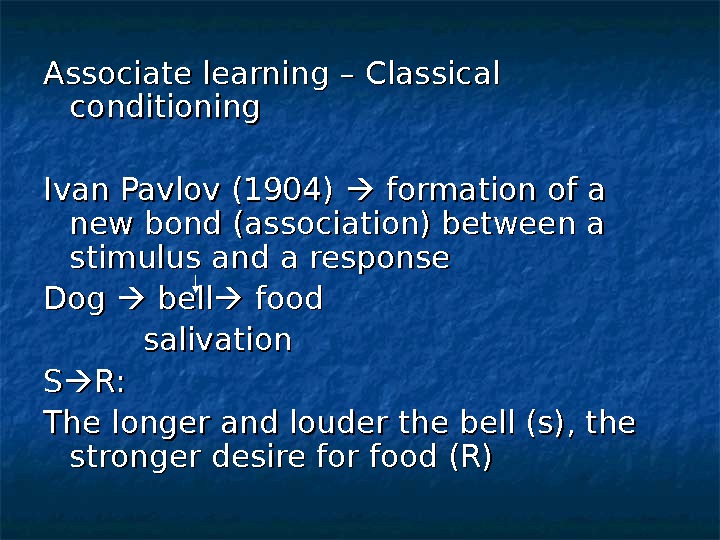
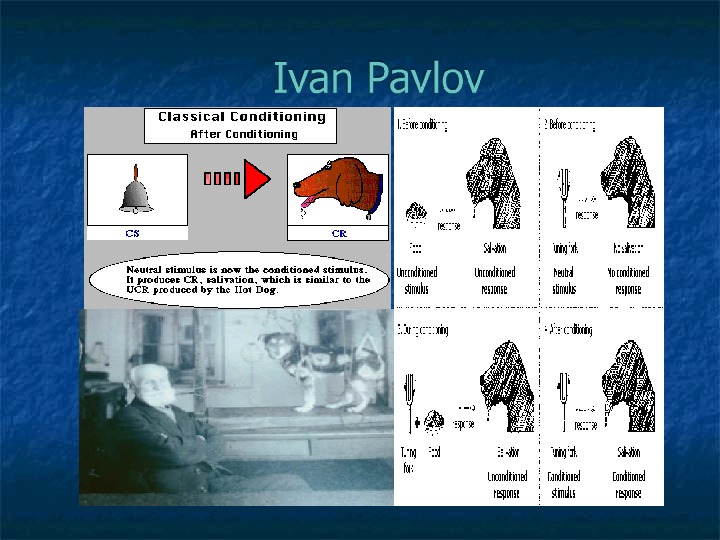
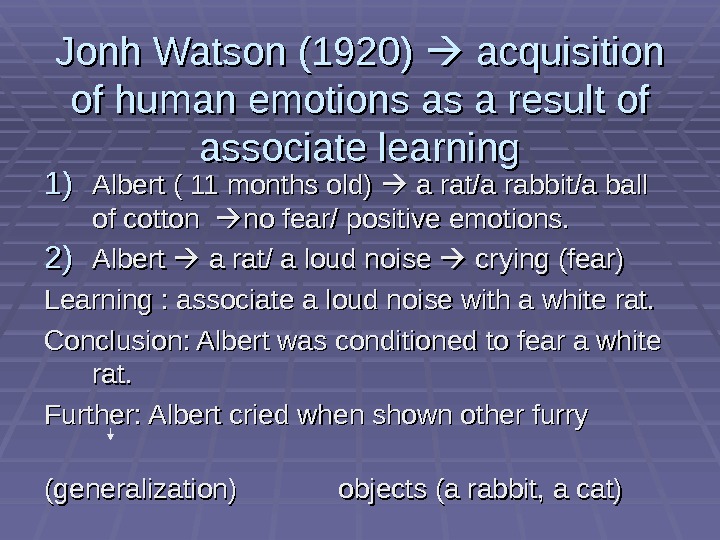
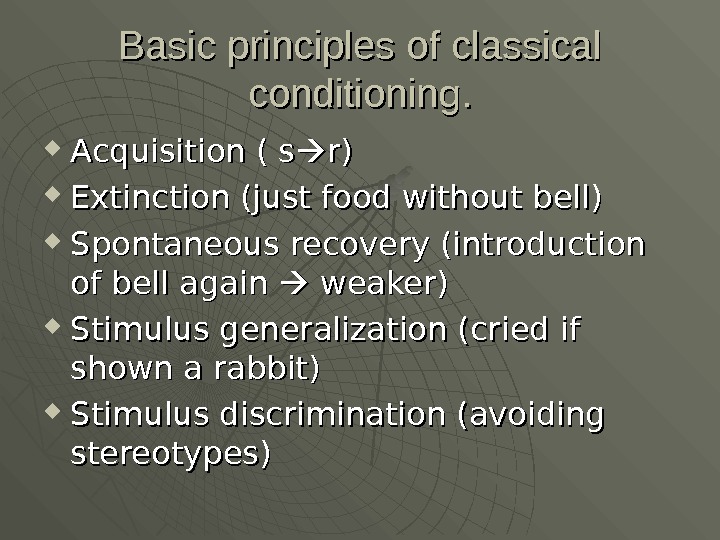

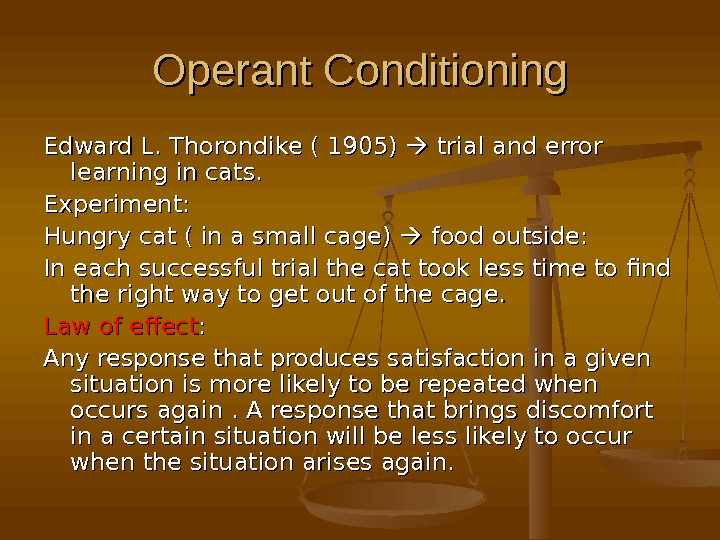
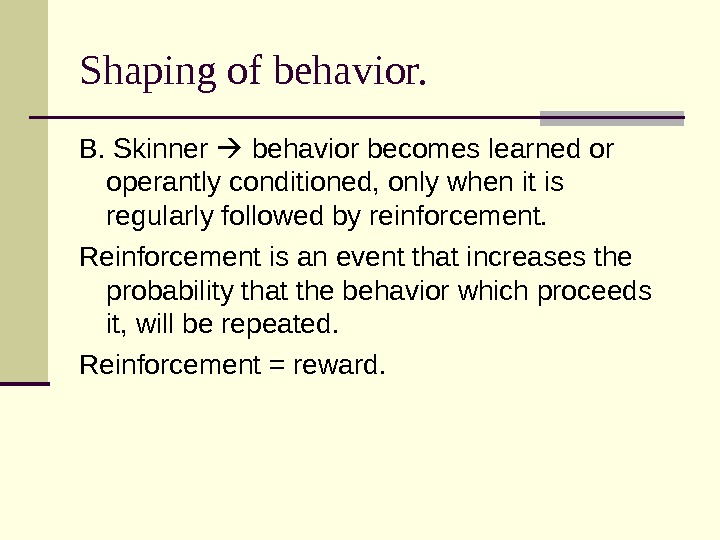
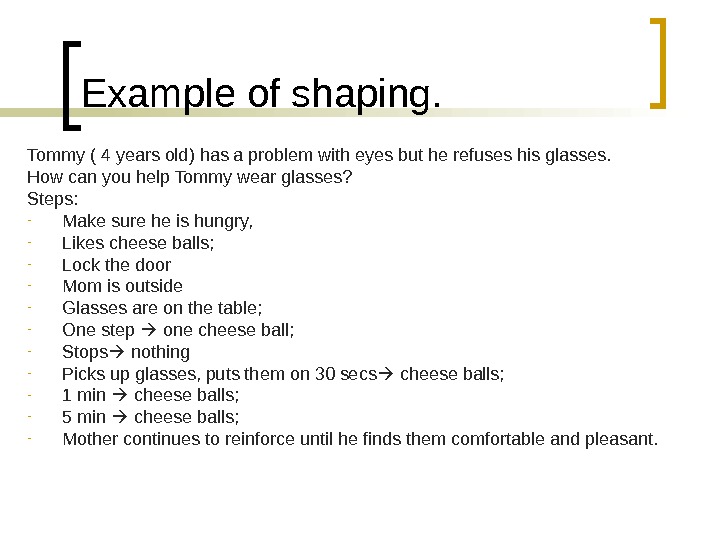


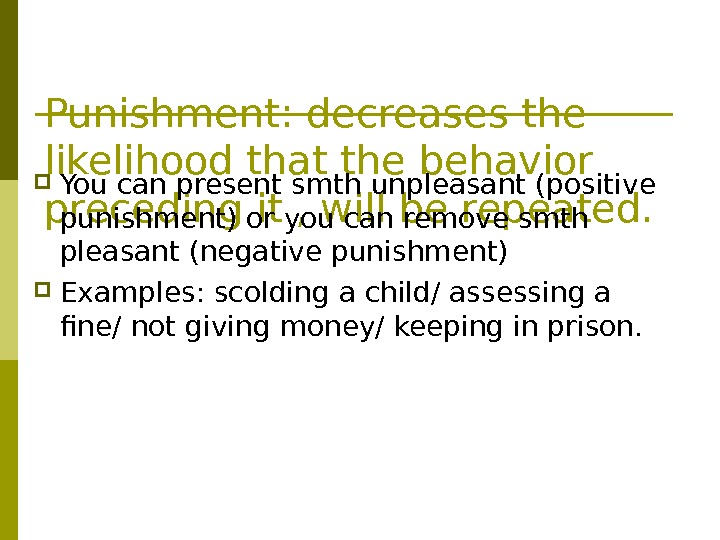
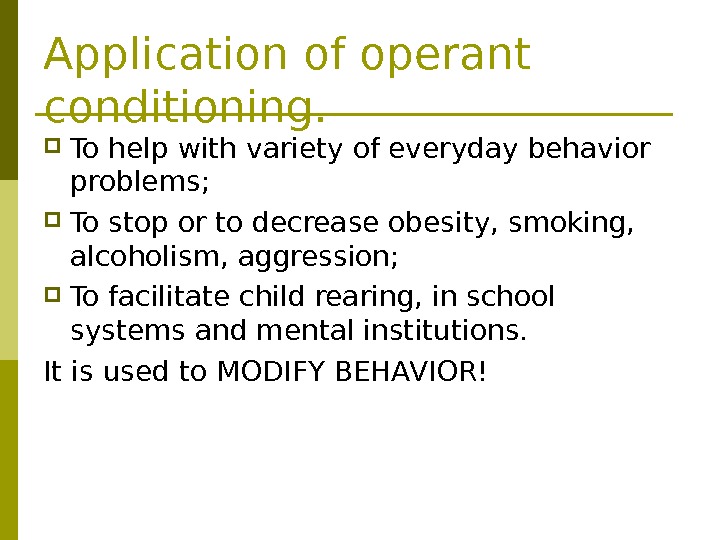
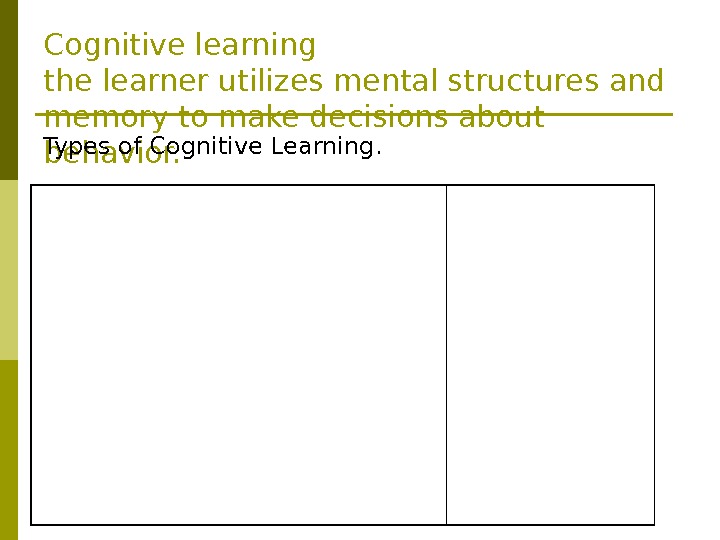
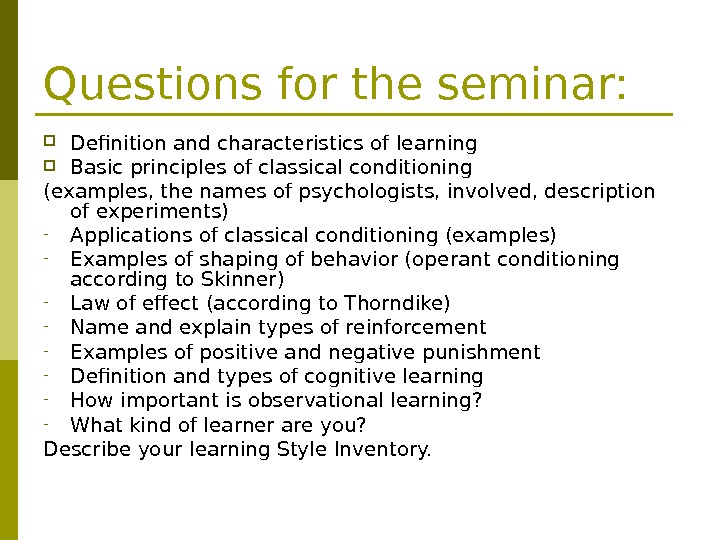
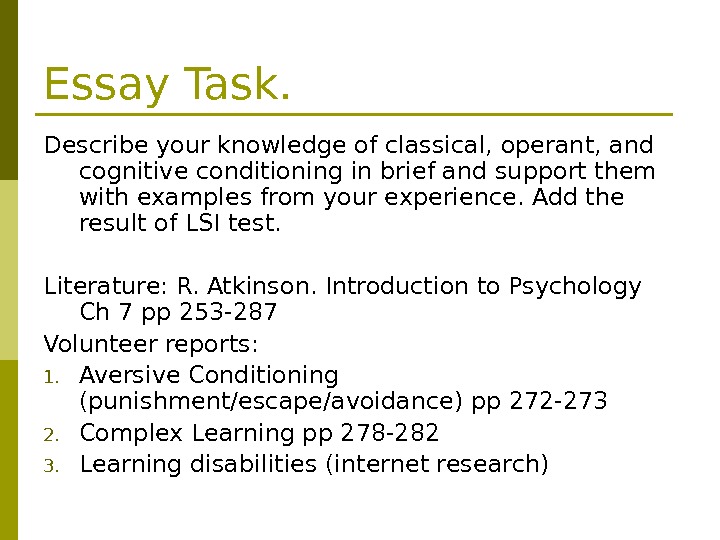
general_psychology_learning_6-7.ppt
- Размер: 1.9 Mегабайта
- Количество слайдов: 18
Описание презентации General Psychology lectures 6 -7 Learning: 1. 1. по слайдам
 General Psychology lectures 6 -7 Learning: 1. 1. Characteristics of learning. 2. 2. Classical conditioning 3. 3. Operant conditioning 4. 4. Cognitive learning
General Psychology lectures 6 -7 Learning: 1. 1. Characteristics of learning. 2. 2. Classical conditioning 3. 3. Operant conditioning 4. 4. Cognitive learning
 Characteristics of learning — long-lasting changes of behavior ( not temporary like in hunger or fatigue) — Occurs as a result of experience — Associations between the events in the environments (stimuli) and our behavior (responses) — Learning + motivation = performance.
Characteristics of learning — long-lasting changes of behavior ( not temporary like in hunger or fatigue) — Occurs as a result of experience — Associations between the events in the environments (stimuli) and our behavior (responses) — Learning + motivation = performance.
 Examples : We learn that -some restaurants serve better food than other through experience of eating in them; — We change our behavior by continuing to eat in better ones.
Examples : We learn that -some restaurants serve better food than other through experience of eating in them; — We change our behavior by continuing to eat in better ones.
 Associate learning – Classical conditioning Ivan Pavlov (1904) formation of a new bond (association) between a stimulus and a response Dog bell food salivation SS R: R: The longer and louder the bell (s), the stronger desire for food (R)
Associate learning – Classical conditioning Ivan Pavlov (1904) formation of a new bond (association) between a stimulus and a response Dog bell food salivation SS R: R: The longer and louder the bell (s), the stronger desire for food (R)

 Jonh Watson (1920) acquisition of human emotions as a result of associate learning 1)1) Albert ( 11 months old) a rat/a rabbit/a ball of cotton no fear/ positive emotions. 2)2) Albert a rat/ a loud noise crying (fear) Learning : associate a loud noise with a white rat. Conclusion: Albert was conditioned to fear a white rat. Further: Albert cried when shown other furry (generalization) objects (a rabbit, a cat)
Jonh Watson (1920) acquisition of human emotions as a result of associate learning 1)1) Albert ( 11 months old) a rat/a rabbit/a ball of cotton no fear/ positive emotions. 2)2) Albert a rat/ a loud noise crying (fear) Learning : associate a loud noise with a white rat. Conclusion: Albert was conditioned to fear a white rat. Further: Albert cried when shown other furry (generalization) objects (a rabbit, a cat)
 Basic principles of classical conditioning. Acquisition ( s r)r) Extinction (just food without bell) Spontaneous recovery (introduction of bell again weaker) Stimulus generalization (cried if shown a rabbit) Stimulus discrimination (avoiding stereotypes)
Basic principles of classical conditioning. Acquisition ( s r)r) Extinction (just food without bell) Spontaneous recovery (introduction of bell again weaker) Stimulus generalization (cried if shown a rabbit) Stimulus discrimination (avoiding stereotypes)
 Applications of classical conditioning -widely used in therapies (enuresis) -to reduce fears (shown a snake and then given an ice-cream) -if you are aware of stimuli in your environment that elicit responses from you, you may FORM and ELIMINATE your EMOTIONAL REACTIONS.
Applications of classical conditioning -widely used in therapies (enuresis) -to reduce fears (shown a snake and then given an ice-cream) -if you are aware of stimuli in your environment that elicit responses from you, you may FORM and ELIMINATE your EMOTIONAL REACTIONS.
 Operant Conditioning Edward L. Thorondike ( 1905) trial and error learning in cats. Experiment: Hungry cat ( in a small cage) food outside: In each successful trial the cat took less time to find the right way to get out of the cage. Law of effect : : Any response that produces satisfaction in a given situation is more likely to be repeated when occurs again. A response that brings discomfort in a certain situation will be less likely to occur when the situation arises again.
Operant Conditioning Edward L. Thorondike ( 1905) trial and error learning in cats. Experiment: Hungry cat ( in a small cage) food outside: In each successful trial the cat took less time to find the right way to get out of the cage. Law of effect : : Any response that produces satisfaction in a given situation is more likely to be repeated when occurs again. A response that brings discomfort in a certain situation will be less likely to occur when the situation arises again.
 Shaping of behavior. B. Skinner behavior becomes learned or operantly conditioned, only when it is regularly followed by reinforcement. Reinforcement is an event that increases the probability that the behavior which proceeds it, will be repeated. Reinforcement = reward.
Shaping of behavior. B. Skinner behavior becomes learned or operantly conditioned, only when it is regularly followed by reinforcement. Reinforcement is an event that increases the probability that the behavior which proceeds it, will be repeated. Reinforcement = reward.
 Example of shaping. Tommy ( 4 years old) has a problem with eyes but he refuses his glasses. How can you help Tommy wear glasses? Steps: — Make sure he is hungry, — Likes cheese balls; — Lock the door — Mom is outside — Glasses are on the table; — One step one cheese ball; — Stops nothing — Picks up glasses, puts them on 30 secs cheese balls; — 1 min cheese balls; — 5 min cheese balls; — Mother continues to reinforce until he finds them comfortable and pleasant.
Example of shaping. Tommy ( 4 years old) has a problem with eyes but he refuses his glasses. How can you help Tommy wear glasses? Steps: — Make sure he is hungry, — Likes cheese balls; — Lock the door — Mom is outside — Glasses are on the table; — One step one cheese ball; — Stops nothing — Picks up glasses, puts them on 30 secs cheese balls; — 1 min cheese balls; — 5 min cheese balls; — Mother continues to reinforce until he finds them comfortable and pleasant.
 Basic principles of Operant Conditioning. Acquisition S– R – reinforcement Extinction (withholding reinforcement) Spontaneous recovery (if you fail the exam after working hard, you may try harder next semester) Generalization calling all men ‘daddy’ Discrimination reinforce the child when he calls only his father ‘daddy’.
Basic principles of Operant Conditioning. Acquisition S– R – reinforcement Extinction (withholding reinforcement) Spontaneous recovery (if you fail the exam after working hard, you may try harder next semester) Generalization calling all men ‘daddy’ Discrimination reinforce the child when he calls only his father ‘daddy’.
 Types of reinforcement -continuous reinforcement (every correct answer is reinforced with high rate) -partial reinforcement (operant response is even stronger) -primary reinforcement (food for a hungry/water for a thirsty) -secondary reinforcement (thought as satisfying, pleasant) -negative reinforcement (when removed, strengthens the behavior)
Types of reinforcement -continuous reinforcement (every correct answer is reinforced with high rate) -partial reinforcement (operant response is even stronger) -primary reinforcement (food for a hungry/water for a thirsty) -secondary reinforcement (thought as satisfying, pleasant) -negative reinforcement (when removed, strengthens the behavior)
 Punishment: decreases the likelihood that the behavior preceding it , will be repeated. You can present smth unpleasant (positive punishment) or you can remove smth pleasant (negative punishment) Examples: scolding a child/ assessing a fine/ not giving money/ keeping in prison.
Punishment: decreases the likelihood that the behavior preceding it , will be repeated. You can present smth unpleasant (positive punishment) or you can remove smth pleasant (negative punishment) Examples: scolding a child/ assessing a fine/ not giving money/ keeping in prison.
 Application of operant conditioning. To help with variety of everyday behavior problems; To stop or to decrease obesity, smoking, alcoholism, aggression; To facilitate child rearing, in school systems and mental institutions. It is used to MODIFY BEHAVIOR!
Application of operant conditioning. To help with variety of everyday behavior problems; To stop or to decrease obesity, smoking, alcoholism, aggression; To facilitate child rearing, in school systems and mental institutions. It is used to MODIFY BEHAVIOR!
 Cognitive learning the learner utilizes mental structures and memory to make decisions about behavior. Types of Cognitive Learning. Insight Latent Observational Problem solving, the process of learning the solution without error-and-trial. Monkey – bananas- boxes Acquiring knowledge of smth and does not show it until motivated to do so. (cognitive maps) Children imitate the adult role model. (good or bad) especially when it is reinforced.
Cognitive learning the learner utilizes mental structures and memory to make decisions about behavior. Types of Cognitive Learning. Insight Latent Observational Problem solving, the process of learning the solution without error-and-trial. Monkey – bananas- boxes Acquiring knowledge of smth and does not show it until motivated to do so. (cognitive maps) Children imitate the adult role model. (good or bad) especially when it is reinforced.
 Questions for the seminar: Definition and characteristics of learning Basic principles of classical conditioning (examples, the names of psychologists, involved, description of experiments) — Applications of classical conditioning (examples) — Examples of shaping of behavior (operant conditioning according to Skinner) — Law of effect (according to Thorndike) — Name and explain types of reinforcement — Examples of positive and negative punishment — Definition and types of cognitive learning — How important is observational learning? — What kind of learner are you? Describe your learning Style Inventory.
Questions for the seminar: Definition and characteristics of learning Basic principles of classical conditioning (examples, the names of psychologists, involved, description of experiments) — Applications of classical conditioning (examples) — Examples of shaping of behavior (operant conditioning according to Skinner) — Law of effect (according to Thorndike) — Name and explain types of reinforcement — Examples of positive and negative punishment — Definition and types of cognitive learning — How important is observational learning? — What kind of learner are you? Describe your learning Style Inventory.
 Essay Task. Describe your knowledge of classical, operant, and cognitive conditioning in brief and support them with examples from your experience. Add the result of LSI test. Literature: R. Atkinson. Introduction to Psychology Ch 7 pp 253 -287 Volunteer reports: 1. Aversive Conditioning (punishment/escape/avoidance) pp 272 -273 2. Complex Learning pp 278 -282 3. Learning disabilities (internet research)
Essay Task. Describe your knowledge of classical, operant, and cognitive conditioning in brief and support them with examples from your experience. Add the result of LSI test. Literature: R. Atkinson. Introduction to Psychology Ch 7 pp 253 -287 Volunteer reports: 1. Aversive Conditioning (punishment/escape/avoidance) pp 272 -273 2. Complex Learning pp 278 -282 3. Learning disabilities (internet research)

